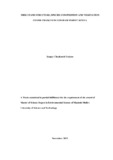| dc.description.abstract | Vegetation is an important variable in land-atmosphere interactions. Sustainable forest
management requires monitoring of vegetation cover dynamics to help improve forest
health. Many studies have been conducted in many forest ecosystems in Kenya but
only a few have analyzed vegetation cover dynamics of the Londiani Forest on tree
stand structural heterogeneity. The main aim of this study was to assess tree stand
structure, species composition and forest cover change in Londiani Forest in Kericho
County over the past 20 years. Specifically, the study aimed to (i) determine tree stand
structure and species composition, (ii) determine forest cover change of Londiani
Forest, and (iii) evaluate the roles of the forest adjacent community (FAC) influencing
vegetation dynamics. Londiani Forest is divided into Kedowa, Chebewor and
Londiani. From each of these blocks transect running 100m from the edge of the
forest were laid. Quadrats measuring 100x100m were established every 200 meters
for the length of the transect. Data on standing/live trees, abundance and tree species
were determined and recorded in a data sheet. Diameter at Breast Height (DBH) was
measured 1.3m from the ground using a diameter tape. Tree height was also measured
using a Suunto clinometer. Nested 25x25m-quadrats for saplings and 1x1m for
seedlings were laid where all the saplings and seedlings for each tree species were
recorded. Stumps of trees which had been cut previously were counted in addition to
identifying tree species which each tree stump was derived from. The use of
Normalized Difference Vegetation Indices (NDVI) to detect forest cover changes was
employed in the study. Landsat Thematic Mapper TM images were acquired and
processed with the Arc Map GIS software version 10. Supervised classification was
carried out to delineate the images into three classes (forest, grasslands/ bush lands
and bare lands/ water bodies) to analyze the extent of forest cover changes in the
selected years (2000, 2003, 2010, 2015 and 2020). Adjacent to each of these forest
blocks, 9 villages were selected using the purposive sampling method. Structured
questionnaires and interviews were administered; Focus group discussions (FGDs)
and interviews were held with the key informants and institutional managers involved
in forest management to ascertain the role of the community in vegetation dynamics.
Quantifiable data were entered in Ms Excel for data management and calculation of;
Total density, species density, diversity, abundance, richness, similarity, evenness and
basal area. Predictive Analytics Software (PASW) version 25 was used to analyze
various variables between and within the study sites. A total of 1,308 individual trees
belonging to 34 different species from 24 families were recorded. Kedowa had an
abundance of 457 trees and richness 27, Chebewor 417 trees, richness 19 and
Londiani 434 trees, richness 14. Kedowa block had a diversity of H’= 0.864,
Chebewor H’= 0.855 and Londiani H’= 0.792. A total of 58 charcoal making spots
were recorded. NDVI maps showed that Natural forests increased by 30% between
2000 and 2010, plantation forest increased by 50% between 2000 and 2010. NDVI
values for natural forest ranged from 0.4 recorded in the year 2000 to 0.7 in 2010,
plantation forest 0.2 in 2000 to 0.5 in 2010. The Londiani Forest Adjacent
Communities (FAC) is involved in forest activities confirmed by the high Community
Forest Associations (CFA) membership of 81% under different user groups like
ecotourism at 10%, bee keeping at 6%, seed and seedling collection at 30% and tree
nursery at 53%. The study findings would inform sound decision making on forest
management and recommends for adoption of its findings and suggestions by forest
management institutions and agencies for a better understanding of forest cover
changes which is urgently needed to strengthen operations on forest management. | en_US |

